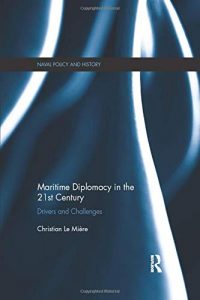
Maritime Diplomacy in 21st Century, drivers and challenges by Christian Le Miere was published in 2014. The book deals with the concept of maritime diplomacy from its historical roots to the present. Gunboat Diplomacy has become an old concept and is now a subset of Maritime Diplomacy. It suggests a new definition of this concept and elaborates on different types, categories and properties of Maritime Diplomacy. The book also lays out important differences between Naval and Maritime Diplomacy as the latter constitutes many non-military agencies. The most important contribution of this book is the application of the Game theory to Maritime Diplomacy. Therefore this book is a comprehensive guide to Maritime Diplomacy in the 21st Century.
The first chapter traces the definition of maritime diplomacy through a historical lens. The concept of maritime diplomacy is not a new phenomenon, in fact, gunboat, diplomacy had been a part of diplomatic ties for centuries. The chapter begins with the example of China’s maritime diplomacy through its first African voyage- Peace Ark, which was sent to developing African countries in order to provide medical assistance. This suggests that maritime initiatives can have both diplomatic and philanthropic implications for the states involved. The chapter then moves forward to distinguish between three types of maritime diplomacy- Cooperative, Persuasive and Coercive. It defines each one of them using practical examples giving the readers a clear understanding of their differences. The author points out that the definitions given by earlier theorists, especially James Cable have become quite outdated and requires a fresh perspective. This perspective should include defining the actors involved, the activities undertaken and the goals and victims of maritime diplomacy. The chapter then analyses each of these constituents in order to provide the reader with a final definition of maritime diplomacy. The author concludes that maritime diplomacy is a spectrum of activities that allows policymakers to achieve long term objectives through the fulfilment of a chasm between war and civilian diplomacy.
The second chapter deals with Para gunboat diplomacy which has become a trend among many states. This includes the usage of non-military or paramilitary forces and similar tactics as used in coercive maritime diplomacy. The use of paramilitaries was scarce during the time of the second world war. However, with changing times there has been growth in its size and mandate. The chapter then traces the reasons behind the growth of maritime paramilitary diplomacy with a special focus on the Asia-Pacific. A lot of references are given to Chinese paramilitaries as well as those becoming increasingly conscious of their strategic position such as Japan, South Korea and Malaysia. The author then elaborates the benefits of using paramilitaries rather than any other form of the military at the sea and ends the chapter with a discussion on the scope of Para gunboat diplomacy.
The third chapter gives a detailed description of various categories and properties of maritime diplomacy. The chapter uses Cable’s categorization in order to provide a clear understanding of various events that takes place all over the world. Although the author admits that it is difficult to categorize maritime events into simplified categories, as they are complex and unique. He further divides maritime events into kinetic and non-kinetic operations. There are various properties of maritime diplomacy such as medium, message, time, the balance of power etc. which is explained in the chapter through visualization.
The fourth chapter focuses on the utility of maritime diplomacy. It begins with the assumption that coercive maritime diplomacy has seen a downfall after the cold war due to increasing cost and loss of overseas bases. Many scholars suggested that maritime diplomacy will be of less utility in the coming years due to technological changes as well as international laws that put restrictions on maritime activities. The chapter then argues that despite these assumptions there is a fair number of reasons to believe that maritime diplomacy will continue to be a useful tool in international relations. Due to media coverage, international legal systems and the increase of democratization process among societies, the use of violence in warfare has become limited. This makes it convenient for policymakers to kill two birds with one stone i.e. use maritime diplomacy to achieve diplomatic objectives without causing violence or conflict.
In the fifth chapter, the author brings out other contemporary drivers of maritime diplomacy in the 21st century. It analyses these factors in detail with appropriate case studies. These factors range from political to legal, moral to technological and so on. Nationalism and sovereignty, International Law, an increasingly multipolar world, changing characteristics of war and global financial crises have affected the usage of maritime diplomacy as a tool to attain diplomatic goals. With the advent of advanced technologies, the utility of maritime forces has gradually increased. However, several new diplomatic tactics may reduce the usage of maritime diplomacy such as China’s initiative of imposing sanctions before resorting to coercive maritime diplomacy. Thus, the utility of maritime diplomacy is two-pronged- it provides a platform for building alliances as well as extend it for a more coercive form of diplomacy.
The final chapter focuses on the application of game theory in maritime diplomacy. Game theory is directly relevant for maritime diplomacy. It allows studying how two parties make decisions in a situation of conflict. Decision-making is an important component of all types of maritime diplomacy. The author thus attempts to analyse maritime diplomacy through game theory. Firstly, he applies the theory to coercive maritime diplomacy and subsequently to cooperative maritime diplomacy. Further, it is acknowledged that sometimes the players don’t make decisions at the same time. Therefore, a new form of game theory needs to be developed which is called “The Sequential Game”. This model is further explained with sequential modelling of the 1973 Mediterranean stand-off and the Syrian crisis of 2013. Despite the relevancy of game theory to study maritime diplomacy, there are certain limitations that limit our analysis. These include the broad and complex nature of conflicts in the real world, the multiplicity of actors involved, diversity etc. The Game Theory gives very limited options to the players whereas in reality, decision-makers have a plethora of options. The author admits that in reality the relevancy of game theory in maritime affairs have not been applied yet and therefore it is just a theory at present.
The book concludes with a quote from Sun Tzu’s Art of war which is partially true for maritime diplomacy- To subdue the enemy without fighting is the acme of skill. Maritime diplomacy remains a less explored tool for international relations. Thus there is a need to refocus our attention on Maritime Diplomacy because the 21st century is the century of Maritime.













